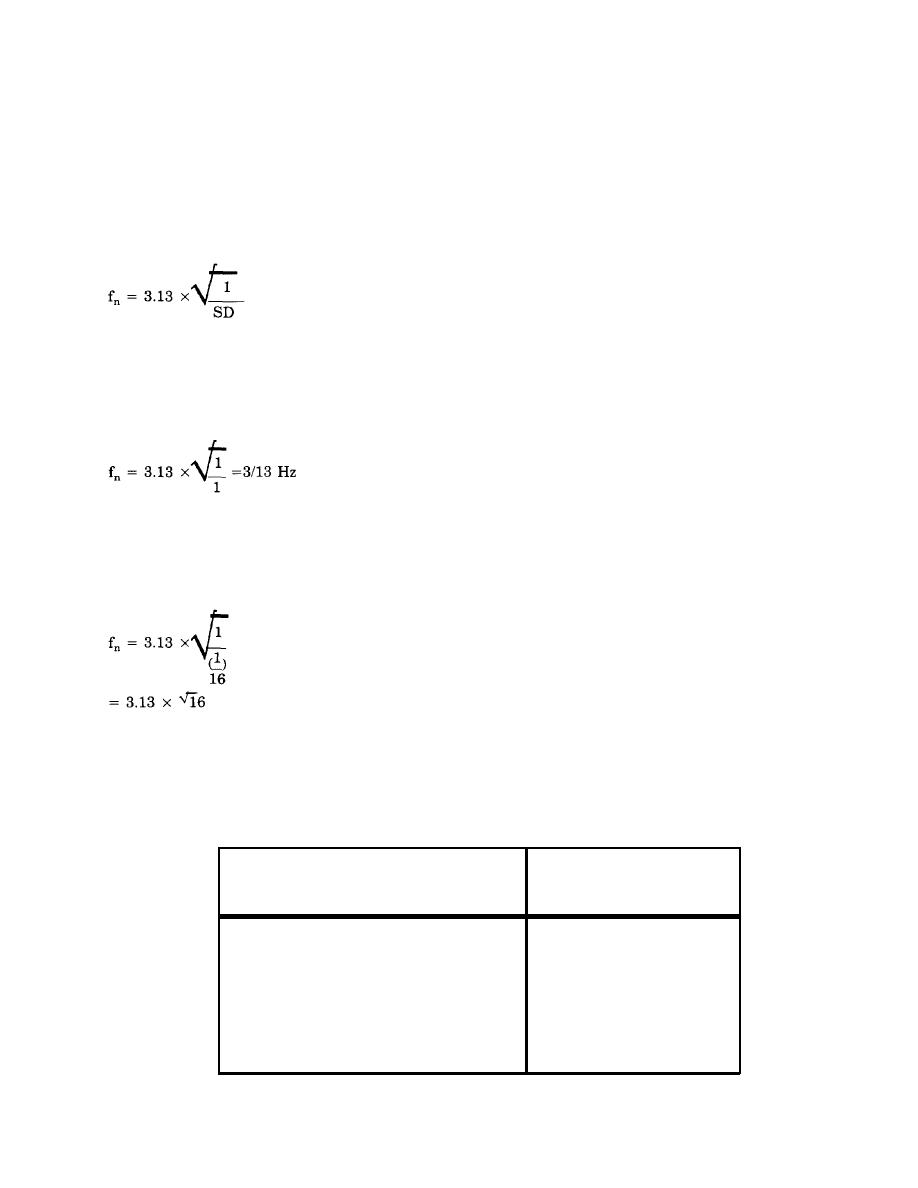
TM 5-805-4/AFJMAN 32-1090
the form of "stiffness" values. For example, a
even pads of cork and felt when operating in their
proper load range.
stiffness of 400 lb/in. means that a 400 lb load will
c. Application suggestions. Table B-3 provides a
produce a 1 inch static deflection, or that an 800 lb
suggested schedule for achieving various degrees
load will produce a 2 inch deflection, assuming that
of vibration isolation in normal construction. The
the mount has freedom to deflect a full 2 inches.
table is based on the transmissibility curve, but
b. Natural frequency of a mount. The natural
suggests operating ranges of the ratio of driving
frequency of steel springs and most other vibration
frequency to natural frequency. The terms "low,"
isolation materials can be calculated approxi-
"fair," and "high" are merely word descriptors,
mately from the formula in equation B-17.
but they are more meaningful than such terms as
95 or 98 percent isolation efficiency which are
clearly erroneous when they do not take into
account the mass and stiffness of the floor slab.
(eq B-17)
Vibration control recommendations given in this
where fn is the natural frequency in Hz and S.D.
chapter are based on the application of this table.
is the static deflection of the mount in inches.
(1) Example. Suppose an 1800-rpm motor-
(1) Example, steel spring. Suppose a steel
pump unit is mounted on steel springs having
spring has a static deflection of 1 inch when placed
l-inch static deflection (as in the example under
under one corner of a motor-pump base. The
b(1) above). The driving frequency of the system is
natural frequency of the mount is approximately:
the shaft speed, 1800 rpm or 30 Hz. The natural
frequency of the mount is 3 Hz, and the ratio of
driving frequency to natural frequency is about 10.
(eq B-17)
Table B-3 shows that this would provide a "fair"
(2) Example, rubber pad. Suppose a layer of
to "high" degree of vibration isolation of the motor
3/8-inch-thick ribbed neoprene is used to vibration
pump at 30 Hz. If the pump impeller has 10
isolate high-frequency structure borne noise or
blades, for example, this driving frequency would
vibration. Under load, the pad is compressed
be 300 Hz, and the ratio of driving to natural
enough to have a 1/16-inch static deflection. The
frequencies would be about 100; so the isolator
natural frequency of the mount is approximately:
would clearly give a "high" degree of vibration
isolation for impeller blade frequency.
(2) Caution. The suggestion on vibration isola-
tion offered in the manual are based on experi-
ences with satisfactory installations of conven-
tional electrical and mechanical HVAC equipment
in buildings. The concepts and recommendations
= 3.13 x 4 = 12 Hz
described here may not be suitable for complex
machinery, w i t h unusual vibration modes,
This formula usually has an accuracy to within
mounted on complex isolation systems. For such
about plus or minus 20 percent for material such
problems, assistance should be sought from a
as neoprene-in-shear, ribbed or waffle-pattern neo-
vibration specialist.
prene pads, blocks of compressed glass fiber, and
Table B-3. Suggested Schedule for Estimating Relative Vibration Isolation Effectiveness of a Mounting System.
Ratio of Driving Frequency
Degree of
Vibration
of Source to Natural
Isolation
Frequency of Mount
Amplification
Below 1.4
Negligible
1.4
-
3
Low
3-6
Fair
6
-
10
High
Above 10
B-11


 Previous Page
Previous Page
